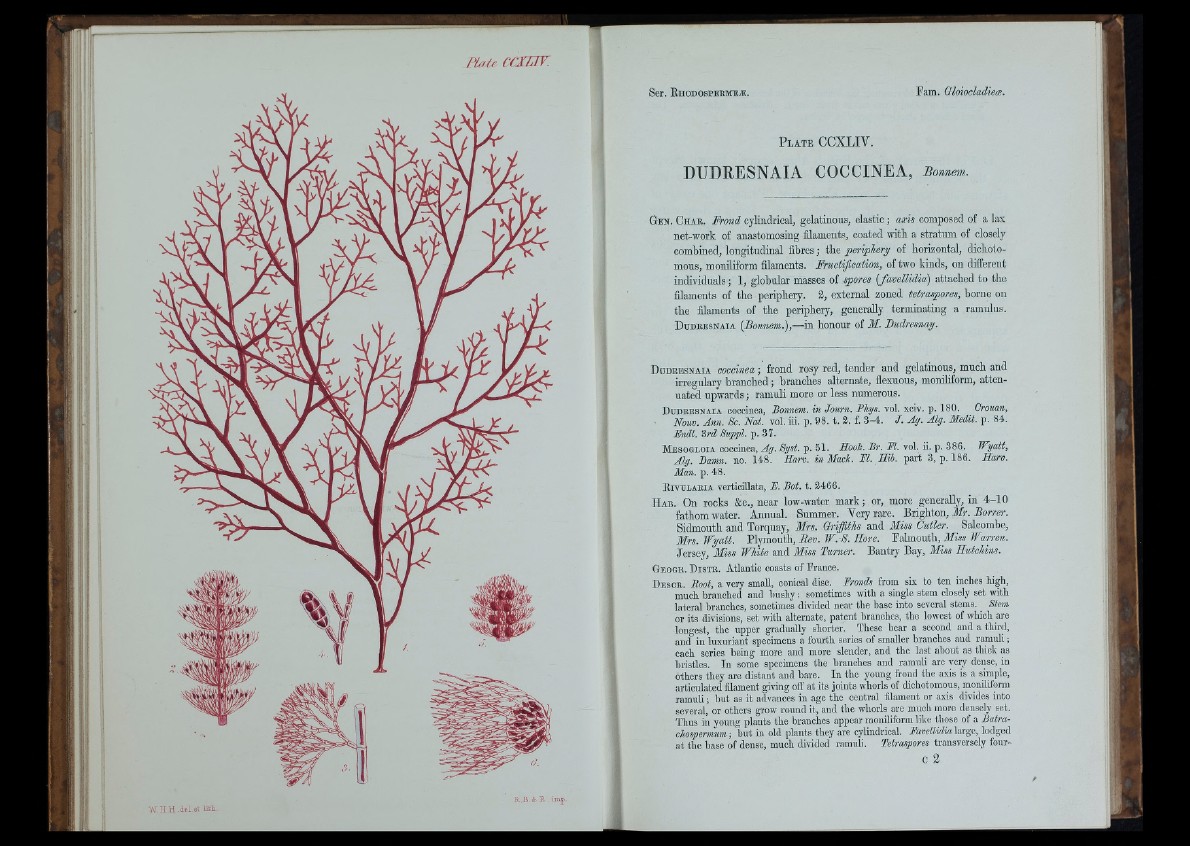
P h i f c c m r .
W.Il.H .d fl et lith.
R .B .t a . irap.
Ser. R hodospeeme* . Fain. Gloiocladiece.
P l a t e CCXLIV.
DUDRESNAIA COCCINEA, JBonnem.
u I I
G en . Ch a e . Frond cylindrical, gelatinous, elastic; axis ooraposed of a lax
net-work of anastomosing filaments, coated with a stratum of closely
combined, longitudinal fibres; the periphery of horizontal, dichotomous,
monfliform filaments. Fructification, of two kinds, on different
individuals; 1, globular masses of spores {favellidia) attached to the
filaments of the periphery. 3, external zoned tetraspores, borne on
the fllaments of the periphery, generally terminating a ramulus.
D hdeesnaia {Bonnem),—in honour of M . .
D udebsnaia coccinea; frond rosy red, tender and gelatinous, much and
irregulary branched; branches alternate, flexuous, moniliform, attenuated
upwards; ramuli more or less numerous.
D u d r e s n a ia c o c c in e a , Bomem. in Bourn. Phys. v o l. x c iv . p . 1 8 0 . Crouan,
Nouv. Ann. So. Nat. vol. iii. p. 98. t. 3. f. 3-4. / . Ay. Alg. p. 84.
Endl. Zrd Suppl. p. 37.
M e s o g io ia coccinea, Ag. Syst. p. 51. Hook. Br. FI. vol. ii. p. 386.
Alg. Damn. no. 148. Harv. in Mack. FI. Hib. part 3, p. 186. Harv.
Man. p. 48.
R iv u l a k ia verticiUata, F. Bot. t. 2466.
H ab. On rooks &c., near low-water mark; or, more generally, in 4-10
fathom water. Annual. Summer. Very rare. Brighton, i f f . Aorrer.
Sidmouth and Torquay, Mrs. Griffiths and Miss Cutler. Salcombe,
Mrs. Wyatt. Plymouth, Ae». W. S. llore. Falmouth, if is i Warren.
Jersey, Miss White and Miss Turner. Bantry Bay, Miss Hutchins.
G e o g e . D i s t e . Atlantic coasts of France.
D e so k . Root, a very small, conical disc. Fronds from six to ten inches high,
much branched and bushy: sometimes with a single stem closely set with
lateral branches, somethnes divided near the base into several stems. Stem
or its divisions, set with alternate, patent branches, the lowest of which are
longest, the upper gradually shorter. These bear a second and a third,
and in luxuriant specimens a fourth series of smaller branches and ramuli;
each series being more and more slender, and the last about as thick as
bristles. In some specimens the branches and ramuli are very dense, in
others they are distant and bare. In the young frond the axis is a simple,
articulated filament giving oft' at its joints whorls of dichotomous, moniliform
ramuli; but as it aelvances in age the central filament or axis divides into
several, or others grow round it, and the whorls are much more densely set.
Thus in young plants the branches appear moniliform like those of a Batra-
cltospermum; but in old plants they are cylindrical. Favellidia large, lodged
at the base of dense, much divided ramuli. Tetraspores transversely four-
C 2